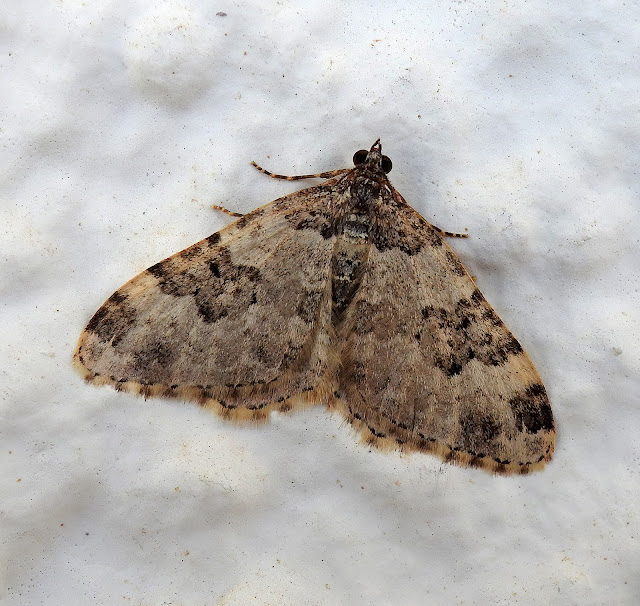This Blog contains Wildlife and Bird Photos from Walks, Safaris, Birding Trips and Vacations. Most of the pictures have been taken with my Nikon P900 and P950X cameras. On the right of the page are labels for each species of Bird/Animal etc. Click on a label to show all of the photos taken for that species. Information for each species is from Wikipedia. Just click on any image for a large picture.
TOTAL PAGEVIEWS
TRANSLATE
Sunday, 2 April 2023
28-3-2023 MONRORO, ANDALUCIA - YELLOW BELLE MOTH (Aspitates ochrearia)
Aspitates ochrearia, the yellow belle, is a moth in the family Geometridae. The species was first described by Pietro Rossi in 1794. It is found in western and southern Europe, as well as North America.
The wingspan is 25–34 mm. Adults are on wing from April to June and again from August to September in two generations per year.
The larvae feed on various herbaceous plants, including Daucus carota and Plantago coronopus. The larvae can be found from April to June. The species overwinters in the larval stage. Pupation takes place in spring.
28-3-2023 SIERRA DE ANDUJAR, ANDALUCIA - EUROPEAN GREENFINCH (Chloris chloris)
The greenfinch was described by Carl Linnaeus in his landmark 1758 10th edition of Systema Naturae under the binomial name Loxia chloris. The specific epithet is from khloris, the Ancient Greek name for this bird, from khloros, "green".
The finch family, Fringillidae, is divided into two subfamilies, the Carduelinae, containing around 28 genera with 141 species and the Fringillinae containing a single genus, Fringilla, with four species. The finch family are all seed-eaters with stout conical bills. They have similar skull morphologies, nine large primaries, 12 tail feathers and no crop. In all species the female bird builds the nest, incubates the eggs and broods the young. Fringilline finches raise their young almost entirely on arthropods, while the cardueline finches raise their young on regurgitated seeds.
A molecular phylogenetic study published in 2012 found that the greenfinches are not closely related to other members of the genus Carduelis. They have therefore been placed in the resurrected genus Chloris that had originally been introduced by the French naturalist Georges Cuvier in 1800, with the European greenfinch as the type species.
Saturday, 1 April 2023
Friday, 31 March 2023
Wednesday, 29 March 2023
Sunday, 26 March 2023
26-3-2023 GANDIA MARJAL, VALENCIA - YELLOW IRIS (Iris pseudacorus)
Iris pseudacorus, the yellow flag, yellow iris, or water flag, is a species of flowering plant in the family Iridaceae. It is native to Europe, western Asia and northwest Africa. Its specific epithet pseudacorus means "false acorus", referring to the similarity of its leaves to those of Acorus calamus (sweet flag), as they have a prominently veined mid-rib and sword-like shape. However, the two plants are not closely related. The flower is commonly attributed with the fleur-de-lis.
The plant was rated in second place for per day nectar production per flower in a UK plants survey conducted by the AgriLand project, which is supported by the UK Insect Pollinators Initiative. However, when number of flowers per floral unit, flower abundance, and phenology were taken into account, it dropped out of the top 10 for most nectar per unit cover per year, as did all plants that placed in the top ten, with the exception of common comfrey, Symphytum officinale.
Saturday, 25 March 2023
Friday, 24 March 2023
Thursday, 23 March 2023
8-3-2023 BIOPARC, VALENCIA - EASTERN BONGO (Tragelaphus eurycerus ssp. isaaci)
The bongo (Tragelaphus eurycerus) is a large, mostly nocturnal, forest-dwelling antelope, native to sub-Saharan Africa. Bongos are characterised by a striking reddish-brown coat, black and white markings, white-yellow stripes and long slightly spiralled horns. It is the only tragelaphid in which both sexes have horns. Bongos have a complex social interaction and are found in African dense forest mosaics. They are the third-largest antelope in the world.
The western or lowland bongo, T. e. eurycerus, faces an ongoing population decline, and the IUCN Antelope Specialist Group considers it to be Near Threatened on the conservation status scale.
The eastern or mountain bongo, T. e. isaaci, of Kenya, has a coat even more vibrant than that of T. e. eurycerus. The mountain bongo is only found in the wild in a few mountain regions of central Kenya. This bongo is classified by the IUCN Antelope Specialist Group as Critically Endangered, with fewer individuals in the wild than in captivity (where it breeds readily).
Subscribe to:
Posts (Atom)






















%201.jpg)
%202.jpg)



%202.jpg)
%203.jpg)








%202.jpg)












